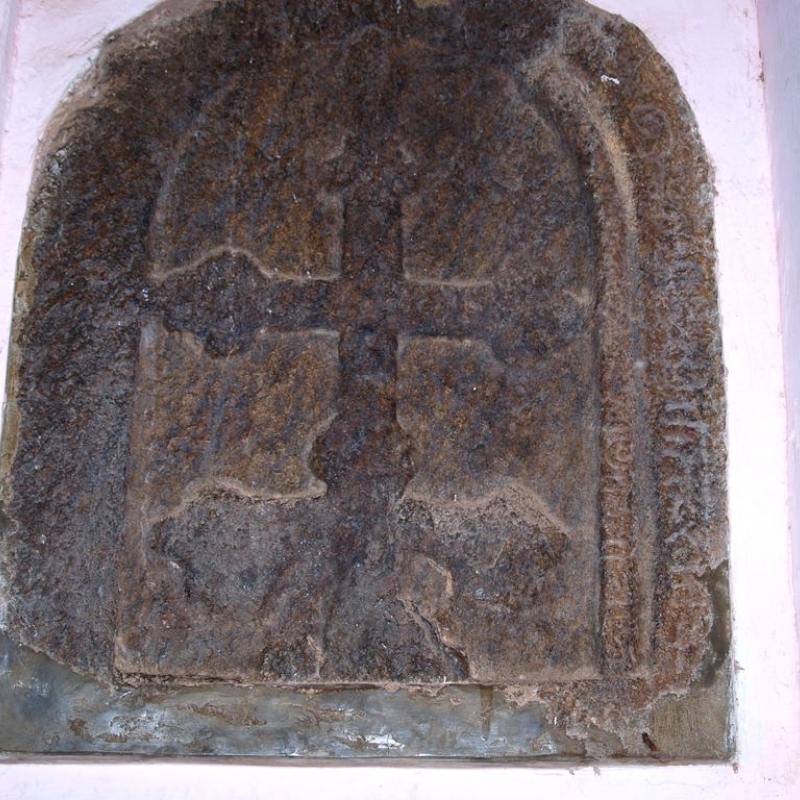Introduction
Pahlavi-inscribed granite bas-relief crosses, found in ancient Christian settlements in South India, are the most ancient artefacts of Saint Thomas Christians in India. The script found on these tablets was established as ‘Pahlavi’, a script used to write Middle Iranian languages. Similar crosses have also been excavated in South Asia and as far east as China, suggesting the religio-cultural patrimony of the East Syriac Christians across this vast area. Scholars have studied these crosses and presented in many reputed oriental conferences and published in many academic journals. It has been agreed that these inscriptions were 'unintelligent' copies of an original template by ‘estampage’, a process of lifting a copy of the original by pressing paper onto its inked surface (Winkworth 1929:237–239).
These crosses were dated from the 7th century, as the Pahlavi script died out after the collapse of the Sasanian Empire in AD 651. This assumption was based on studies of the famous Saint Thomas Mount Cross at Mailappore and the crosses at Valiyapally Church in Kottayam. More crosses were later excavated, and further epigraphic studies suggest that the Pahlavi-inscribed cross at Alangad may be from as early as the 4th century.
Arthur Coke Burnell (1840–1882), British scholar in oriental languages, studied these crosses and concluded for the first time that the script was Pahlavi. These crosses as a group are known as ‘St. Thomas Crosses’ because of their intimate connection to the Christians of Saint Thomas, though they may not have any direct connection to the Apostle Thomas. Antonio de Gouvea, a Portuguese writer who narrated Archbishop Dom Alexis de Menezes' visits to all the Saint Thomas Christian communities, reported in his book Jornada do Arcebispo, published in 1606, that all the Saint Thomas Christian churches were adorned with plain crosses similar to the miraculous cross of Mailappore, and are popularly called St. Thomas Crosses (Malekandathil 2003:244).
Pahlavi script
Pahlavi script derives from Aramaic, containing Aramaic words and ideograms. The Persian language, of which Pahlavi is the written script, is unique in that it provides a direct continuity in recorded texts from before the 5th century BC to the present day. The Iranian languages are grouped as Old Iranian (until 400 BC), Middle Iranian (400 BC to 900 BC) and New Iranian (since AD 900). Old Persian and Avestan were the languages of the Achaemenid period (553–330 BC) whereas Middle Persian was the language of Sasanian period (AD 226–651). Middle Persian is a Western Iranian language, while Avestan is an Eastern Iranian language.
Texts in the Pahlavi script lend an important historical perspective, as they are a testimony to the ancient glory of Persia’s Sasanian Empire—a time when Persia was a major power whose only rival was the neighbouring Roman-Byzantine Empire. All the extant texts in the Pahlavi script date from the post-Sasanian period, and consist of transcriptions of past oral traditions and copies of old manuscripts. Middle Iranian was the official language of the Sasanian Empire and the written language of the Zoroastrian priests. From a linguistic perspective, it provides a direct link from the Old Persian of the 5th century BC to New Persian, said to date from AD 900 (Moyne 1974:27–39).
There are many well-known difficulties associated with reading Pahlavi texts:
1) The alphabet: The Pahlavi language has only 14 characters to denote more than 40 sounds, requiring the modern reader to predict the words and pronunciations. The Avestan alphabet, which has the same origin as Pahlavi, but more than 40 letters, has one of the most comprehensive alphabets, and represents one of the most spectacular achievements of phonetic writing. Avestan is the language in which the Zoroastrian Holy Book, Avesta, was written in the 5th century BC. It is not clear why Avestan was used to write instead of Pahlavi (Moyne 1974:27–39).
2) Ambiguities due to the practice of combining certain letters of the alphabet into complicated ligatures.
3) The abundance of Aramaic ideograms that are written in the Pahlavi script, but read using the equivalent word in the Persian language. For example, min, meaning ‘from’ in Aramaic, is written in Persian and read as az meaning ‘from’ in Persian (Meyers 2014).
4) The scribe tasked with chiselling words into granite is usually forced by the limits of his craft to simplify. For this reason, some of the difficult combinations of letters that are abundant in extant Pahlavi texts have been eliminated from carved artefacts (Moyne 1974:27–39). It is possible that this has impacted the Pahlavi inscriptions on crosses.
Christianity in South India
India’s Christian communities are among the most ancient in the world. According to traditional narratives, including the Ramban Pattu, an oral history finally written down in 1601, the apostle Thomas founded these communities in South India, and was martyred in Mailappore near Chennai. There is strong evidence of the presence of Christianity in India from AD 190. Writings of Eusebius of Caesarea in the early 4th century, and of Saint Jerome in the late 4th century, both refer to the visit of Pantaenus, the head of the Alexandrian school of theology, at the end of the 2nd century (Koonammakkal 2012). Attestations of the local traditions of South India’s Saint Thomas Christians can be found in numerous texts. These include—the Acts of Judas Thomas, which were composed in the 3rd century; the writings of Origen (AD 185–254); the Doctrine of the Apostles from the 3rd century; the writings of Clement in the 3rd century and of Saint Ephrem in the 4th century; texts written by Gregory of Nazianzus, and by Cyrillona, the early Syriac poet; Ambrose of Milan, John Chrysostom, Gaudentius of Brescia, Jerome, Paulinus of Nola, and Jacob of Sarug of the 5th century; and the writings of Gregory of Tours, Gregory the Great, and Isidore of Seville from the 6th century (Koonammakkal 2012).
The Cross, a universal symbol of Christianity
The cross was originally a symbol of punishment. The primitive Christians adopted fish as their symbol. With theological development, the cross became the sign of victory and salvation. By the 4th century, when Emperor Constantine officially recognised Christianity, the cross became a public symbol of the religion. With time, and influenced by the perception of the Christian faith by local cultures, different designs of crosses, with regional variations, emerged. The characteristic Gaelic cross is a symbol of the ancient Gaelic Christians, and the Armenian Khachkar cross is a religio-cultural symbol specific to Armenian Christians. In this way, the design of Pahlavi-inscribed crosses became the religio-cultural symbol of Christianity in ancient India.
Pahlavi-inscribed crosses of South India
Eight granite crosses of this type have been excavated at the sites of ancient Saint Thomas Christian communities in South India. There are reports of three more in Sri Lanka, of which only one is extant today and one can be found in the museum at Anuradhapura.
The basic structure of all these crosses is similar. They are bas-relief sculptures on granite tablets, taking the form of a plain cross with three ‘buds’ or ‘pearls’ on each end. A dove on above, and at the bottom are upward- and downward-directed floral designs. Three steps lead up to the base of the cross. Over the cross is an arch on which is inscribed Pahlavi text.
Crosses of East Syriac tradition in South Asia—The lotus and the cross
It is well known that the East Syriac Church was brought as far as China in the early 7th century through the missionary work of Bishop Alopen (Lau 2003:87–88).[i] There is even a tradition that believes Apostle Thomas went to China from South India before his martyrdom at Mailappore (Kesson 1854:3–4).[ii] The Nestorian stele, erected in AD 781 in Sian-Fu, China, refers to Christian missions dating back 150 years earlier (Drake 1962:22). There are several crosses found in China which depict the cross emerging from the lotus flower, a feature common to St. Thomas Crosses (Chan 2010–2011:27–43).
Saint Thomas Christians and their crosses: A locally evolved religio-cultural symbol
When the Portuguese missionaries arrived in India in AD 1498, they found a Christian community on the Malabar Coast which was related to the Patriarch of Babylon—the Patriarch of the East Syriac Church. They found the churches of Saint Thomas Christians adorned with only plain bas-relief crosses on their altars, similar to the one at the shrine of St. Thomas Mount in Mailappor. Antonio de Gouvea’s writings from the early 17th century confirm that these crosses were known locally by the native Christians as ‘Saint Thomas Crosses’ (Malekandathil 2003:244).
Portuguese missionaries found the cross at Mailappore in 1547, while excavating the ruins of an ancient monastery in preparation for the construction of a new building (Iturriotz 1930:160–162). This cross was installed on the altar at the Shrine of Saint Thomas Mount, or Periyamalai, near Chennai; it was venerated by the Portuguese missionaries, and was reported several times to have sweated blood. This cross became famous and was known as the ‘miraculous cross of Mailappore’. During the time of Archbishop Dom Alexis de Menezes, this design of cross was very common in Saint Thomas Christian churches, as reported by Antonio de Gouvea (Malekandathil 2003). The altars of almost all the ancient churches were adorned only by these crosses, not statues or crucifixes. These crosses, therefore, have become the religio-cultural symbol of ancient Christianity in South India, and possibly the only evolved icon of worship among Saint Thomas Christians. They later became even better known among academics when the British archaeologist Arthur Coke Burnell reported that the inscriptions around these crosses are in the Pahlavi script (Burnell 1874:308).[iii] Burnell went on to study the Pahlavi inscriptions on two similar crosses that belonged to the Knanaya Jacobite Church—they were kept in the church at Kottayam. By this time, most of the crosses with this characteristic design had disappeared, probably due to accusation of Nestorian heresy on Syriac rite Bishops coming from Babylon. The lack of interest in crosses of this design by the Antiochene bishops who arrived later was also probably due to their reluctance to be associated with the Nestorian Heresy, which they opposed.
With the new interest in these crosses that arose with Burnell’s discovery, more crosses were discovered in many parts of South India—in Kadamattom in 1924 (Modi 1924); in Muttuchira in 1923 (Hosten 1930:341); Ramanatha Ayyar (1930:75); in Kothanalloor in the 1920s (Hosten 1930:343); in Alangad in 1930 (Missam 1930:78–79); and in Goa in 2001 (Costa 2009:75–80).
Iconography and East Syriac theology of the Pahlavi-inscribed crosses of South India
The East Syriac Church practised great veneration of the cross, even considering the sign of the cross to be a sacrament. There is evidence that as far back as AD 250, East Syrians erected crosses at their tombs (Kollaparambil 1994:29). The Syriac Christian tradition developed a rich symbolism and prominent use of the cross, especially in its liturgy. It holds an important place, particularly in the East Syriac Liturgy of the Hours. The symbolism of the cross gained prominence in the Syriac tradition earlier than it did in other traditions (Nedungatt 2008:386).
In summary, the important stylistic elements found in this genre of crosses are: 1) a plain cross; 2) a pearl-like or bud-like design at the ends of the arms; 3) a descending dove; 4) leaf-like or flower-like elements on either side of the cross, as if the cross emerges from them; 5) a three-stepped pedestal; 6) an arch around the cross; and 7) Pahlavi inscriptions above the arch.
Prabo Mihindukulasuriya (2011) of the Colombo Theological Seminary, comparing the Persian crosses of Sri Lanka and India, comments that the leaf-like designs on either side of the base, the pearl-like elements on the ends of the arms, and the three-stepped pedestal are the three characteristic features of East Syriac crosses common among Sri Lankan and South Indian crosses.
K. Parry (1996:145) of the University of Manchester confirms that plain crosses with flared arms, with two large leaves rising on either side of the base, are associated with East Syrian Christianity.
Leafy elements on crosses: The 'Tree of Life'
The cross emerging from the leaves on either side symbolises the 'Tree of Life'. For the Syriac fathers, the Tree of Life symbolises Christ and the Cross.[iv] In the Syriac language, the term sliva is from the root slb, which means ‘to crucify’. Sliva denotes ‘cross’, and thus means both ‘the one who is crucified’ and ‘the object that is used to crucify’ (Thelly 1999:311). Sliva, therefore, means ‘Christ’.
In Mapranam, near Irinjalakuda, there is an ancient church called Mar Sliva (Holy Cross). The devotees traditionally refer to the sliva as Sliva Muthappan (great Father or Holy Father sliva)—referring to the cross as a person rather than an object. Here, Sliva Muthappan is Christ himself.[v]
Gregory of Nazianzen wrote, ‘Jesus himself is the tree of life, and so it is appropriate to think of his burial as his Person being planted like the cross in the earth’. (Vazhuthanappally 1990 :33). St. Cyril of Jerusalem depicts the cross as ‘the tree that overcomes the sin that came through a tree’ (Vazhuthanappally, 1990 :32).
On considering East Syriac crosses in South India and South Asia as a whole, the leafy elements on either side of the cross could definitely be interpreted as lotus flowers, which are associated with Buddhism. On the Mount Cross at Mailappore, the lotus is even more conspicuous. East Syriac crosses in China also depict what is clearly a lotus at the base. Thus, the three important elements on these crosses are the lotus, the cross and the dove.
The pearl-ended arms
The pearl-like design at the ends of the four arms is also associated with Syriac spirituality. The pearl is a theme that is famous in Syriac devotional literature and iconography and in Syriac poetry.
The Hymn of the Pearl that is mentioned in the apocryphal Acts of Thomas refers to partaking in the kingdom of God (Klijn 1960:154–164). In Hymns of the Pearl, Ephraim the Syrian—the great Syriac father known as the ‘Harp of the Holy Spirit’—highlights the pearl as salvation (McVey 2002:449). Crosses with arms that flare out at their ends into one or three pearls are very common on Christian seals of the Sasanian period. This element is also found in stucco crosses and other Christian artefacts in the Far East. K. Parry (1996) comments that crosses that end in pearls are more representative of the Church of the East than the leafy crosses.
Indian religio-cultural influence
The Pahlavi-inscribed crosses of South India demonstrate their Indian influence specifically with regard to the arch, the pillars and the lotus. The rounded arch is common in Hindu and Buddhist art, and springs from an aquatic object, the makara. The makara torana[vi] is also seen in the Kailasanatha Temple of Ellora, in the 7th century rock temples in Mahabalipuram, at the Vaikuntha Perumal Temple, and the 8th century Kailasanatha temples at Kanchipuram (Bickelmann 1970:66). Many of the ancient South Indian sculptures from Hindu temples in the British Museum in London display the rounded arch. This demonstrates the adoption of local culture in the development of the iconography of South India’s Pahlavi-inscribed granite crosses. The Saint Thomas Cross is an early, or perhaps the earliest, example of inculturated Christian art in India.
Types of Crosses in South India
1. The Famous Cross of Mailappore—the Mount Cross
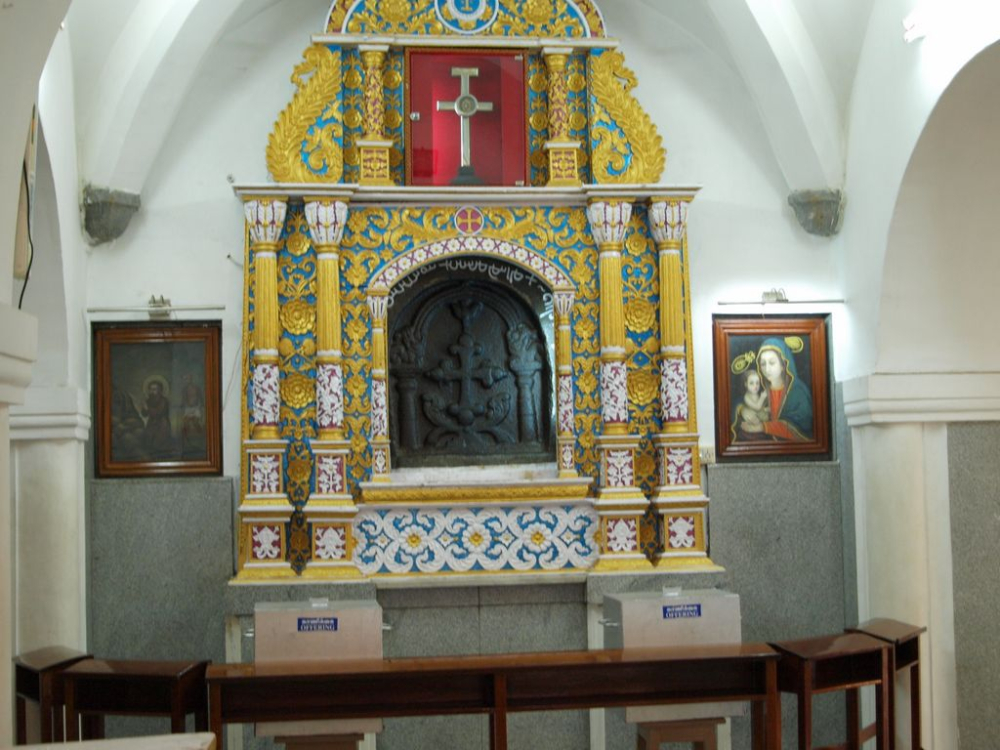
Fig. 1: The Mount Cross
The Mount Cross is the most famous of this genre of crosses. It was excavated from Mailappore, at what is believed to be the site of the martyrdom and the burial of Saint Thomas the Apostle. Saint Thomas Christians have had the tradition of an annual pilgrimage to Mailappore from ancient times. There are several ancient documents that confirm the importance of this site (Medleycot :69–73).[vii]
When the Portuguese arrived, they found the ruins of a monastery at Periyamalai (Saint Thomas Mount), Mailappore. They built a small oratory on this foundation in 1523. Twenty-four years later, they decided to build a larger church, and when excavation began, they found buried in the ground a granite tablet, its engraved front facing down (Joseph, 1928:222–223). This granite tablet has raised edges and a rounded top. The Pahlavi inscriptions are on this rounded edge, with a small cross between the two parts of the inscription. The cross is carved in a niche flanked by two pillars, with an arch above. The rounded arch originates from the open mouth of an aquatic-type figure, the makara.
The cross has three steps at the base. Three downward- and three upward-facing petals have the appearance of a lotus, on which the cross is erected. The arms of the cross end in a three-bud pattern with an additional bud at the end; the bottom arm of the cross is slightly longer. A dove faces down towards the top arm.
2. Crosses of Kottayam Valiyapally
Two similar crosses are found in the church of Kottayam Valiyapally, on each of the side altars. The one on the south altar (the right side as one looks at it) is identical in design to the Mount Cross, but the one on the north altar (on the left side) is slightly different. The north altar cross has no arch or pillars, but rather a pointed border with raised edges, on which the Pahlavi inscriptions are found. These are typical of the two different designs of Pahlavi-inscribed crosses found in the Indian subcontinent. These two crosses, according to legend, were taken from what was then Cranganore (now Kodungallur) in about 1524, when King Samoothiry of Calicut attacked and burned down all three of the ancient churches of Saint Thomas Christians—Saint Mary’s, Saint Kuriakose and Saint Thomas. The Christians took their relics and fled from the area (Mundadan 1967:99–100). These crosses were first brought to Kaduthuruthy, and then were moved to Kottayam in about 1550, when a war took place between the Portuguese and the King of Vadakkumkoor (Kollaparambil 1994:32).[viii]
- Cross at the North Altar (Left Side)
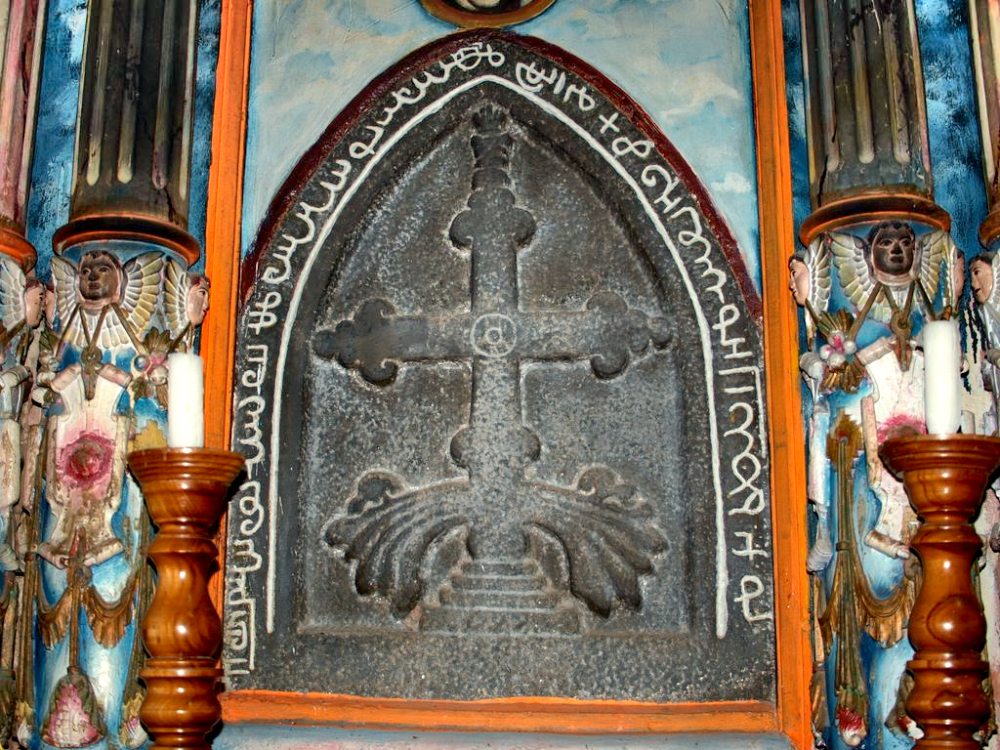
Fig. 2: Crosses of Kottayam Valiyapally: cross at the north altar
This cross is smaller and has a pointed border, in contrast to the rounded upper border of the Mount Cross. The pillars and arch are not seen. The Pahlavi inscription extends over the edge of the slab and outside of the border. The petals at the base of the cross are different from those on the Mount Cross. They are directed downward with only a small bud reaching upward on either end. The arms of the cross are almost equal in length, and the ends have three buds with an additional bud at the end. The dove on the top is smaller, and indistinct—it may be interpreted as either a dove or a flame. This cross is considered the older of the two, as its design is simpler and more primitive.
- Cross at the South Altar (Right Side)
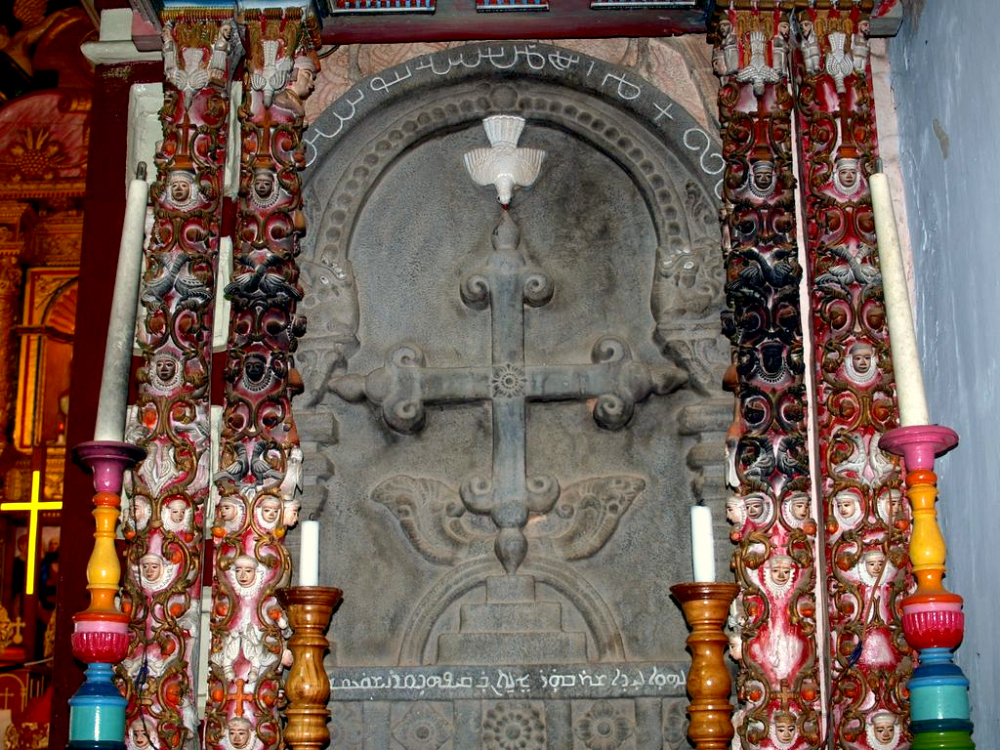
Fig. 3: Crosses of Kottayam Valiyapally: cross at the south altar
This cross is larger, and its design identical to the Mount Cross. Its four arms are almost equal in length and end in a three-bud design with a tongue-shaped, elongated bud at the end. In the centre, where the four arms meet, there is a circular floral design. The dove is well-defined. On the bottom, the three steps are clear, while the downward-facing petals resemble concentric semicircles, but the upward-facing petals are similar to the Mount Cross floral design. The Pahlavi inscriptions are on the raised, rounded, top edges of the slab. East Syriac inscriptions are also seen on the bottom raised edge of the slab; a passage from Galatians 6:14 reads, ‘But far be it from me to glory except in the cross of our Lord Jesus Christ through whom the world has been crucified to me and I to the world’ (Vazhuthanappalli 1990:9). Below the Syriac inscriptions are five or six floral motifs. Above is another small cross similar to the Mount Cross, with two peacocks kissing the ends of the side arms and a floral decoration above (Keay 1960:29). This part is not easily visible now, as it is obscured by the wooden reredos that have been built over it (Hosten 1936:330).
3. Kadamattom Cross
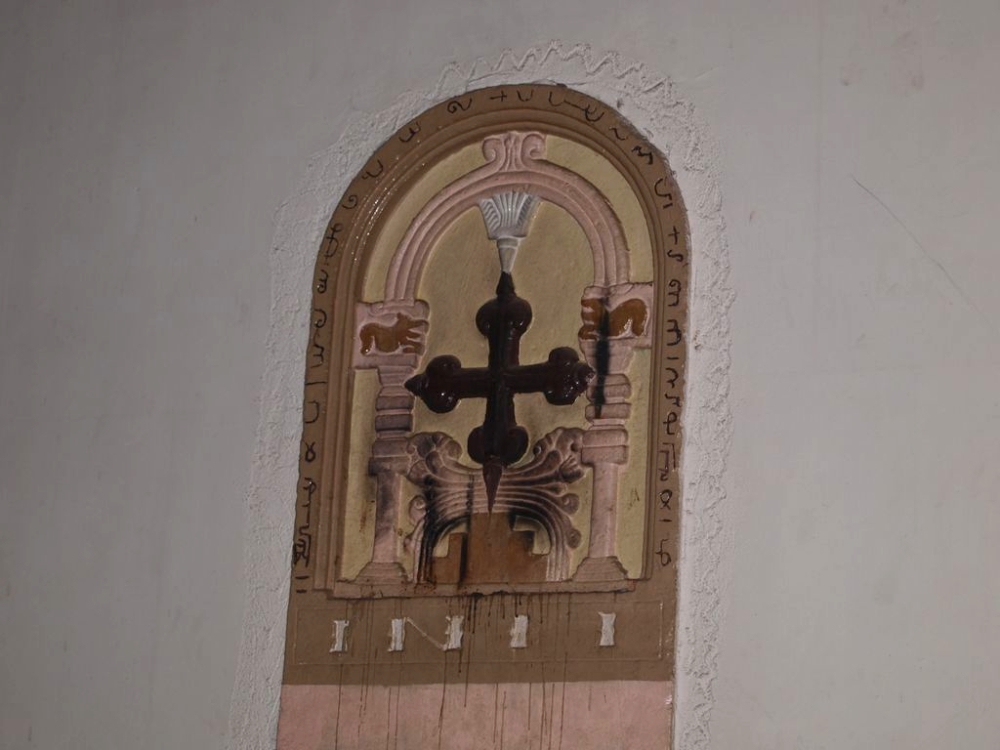
Fig. 4: Kadamattom cross
This cross was found in 1921 (Joseph 1923:355), on the south wall of the altar at the Jacobite Syrian Church at Kadamattom near Muvattupuzha. It resembles the Mount Cross in that there is a carved niche with a rounded border with Pahlavi inscriptions, pillars and an arch with the makara torana. The design of the cross appears slightly primitive in that some of the features—the dove and the buds at the ends of the arms—are not well-defined, though the arch, the pillars, the three steps and the flower design at the bottom are finely finished and well-defined. The base of the niche has an inscription similar to ‘INRI’, which is believed by some to be a further shaping of what was originally five vertical bars (Hosten 1936:338).
The sentences of the inscriptions are divided into three portions with a small cross sign in between, unlike the Mount Cross and the Kottayam cross. J.J. Modi (1926:1–18) deciphered the inscription differently:
- Li zibah vai min Ninav valdenman (I, a beautiful bird from Nineveh, have come to this country )
- Napisht Mar Shapur (written by Mar Shapur)
- Li(mun) ahrob (ahlob) Mashiah avakhshahi min kharbokht (Holy Messiah, the forgiver, freed me from thorn/affliction)
4. Kothanalloor Cross
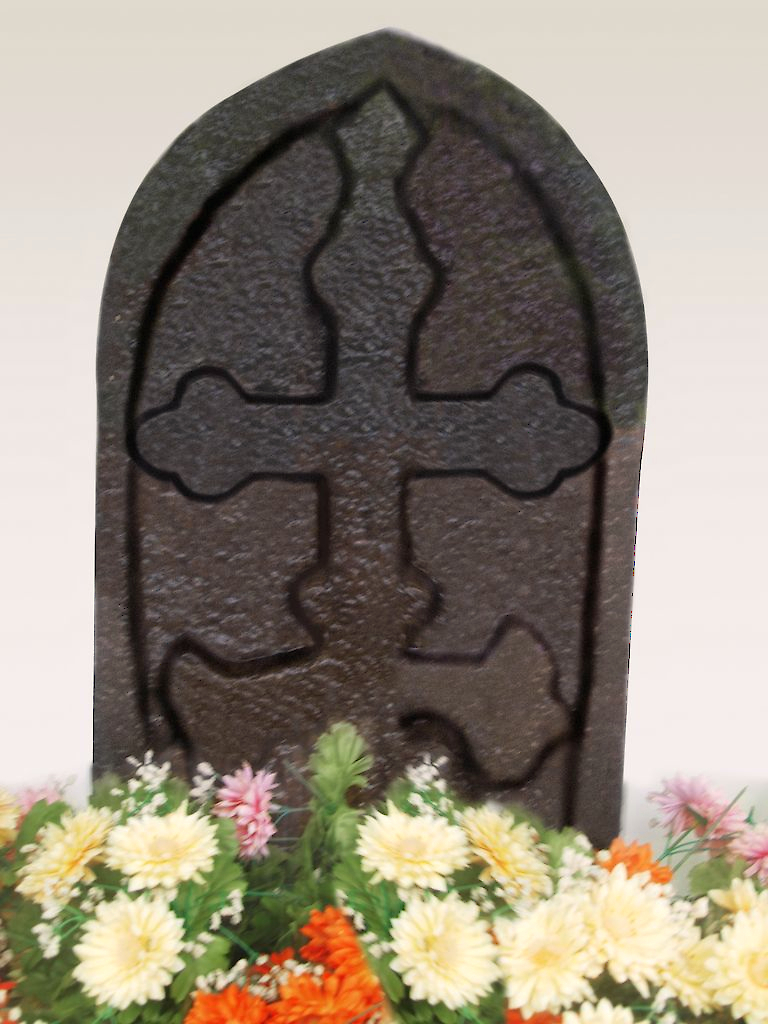
Fig. 5: Kothanalloor cross
This engraved tablet was found in 1921–22, according to Fr Joseph Peediyekkal, at Kothanalloor Gervasius and Protasius Church, Kothanalloor, near Mannanam in the Kottayam District (Hosten 1936:343). This church was commonly known as the Church of Kandeesangal, which in Syriac means ‘saints’ or ‘holy’. The original Church of Kandeesangal was at Pallikkunnu, not far from the present site. This church was believed to have been founded by Mar Sabor and Mar Afroath, two saintly Persian bishops who were also twin brothers. The church was burned down and a new one built at the present site. During the Synod of Diamper, Mar Sabor and Mar Afroath were anathematised as schismatics, and the Portuguese Missionaries decided to rename those churches named after Kandeesangal to ‘all saints’. People at Kothanalloor were resistant to this change and so Archbishop Menezes renamed the church after Saint Gervais and Saint Protasius, identical twin brother saints who lived and were martyred in Milan, as ‘Kandeesangal’.
The church at Kothanalloor was rebuilt many times. The present church is believed to have been built in 1901 (S.S. Gervasis & Prothasis Forane Church 2018). In 1925, Fr Peediyekkal reported that he had found the granite cross tablet in 1921–22, and had instructed the authorities to place the cross in the church (Hosten 1936:343). They seem to have placed the cross on the northern wall of the church, and then later covered it with plaster. In 1987, this cross was accidentally rediscovered under the plaster of the north wall by Rev. Fr Matthew Kizhakke Aranjaniyil of Mutholapuram and Rev. Fr Isaac Kurichiel of Koodalloor (Vazhuthanappalli 1990:16). This cross does not have Pahlavi inscriptions, pillars or an arch, but it has raised edges with a pointed top. The dove is not well-defined and the finish is raw.
5. Muttuchira Cross
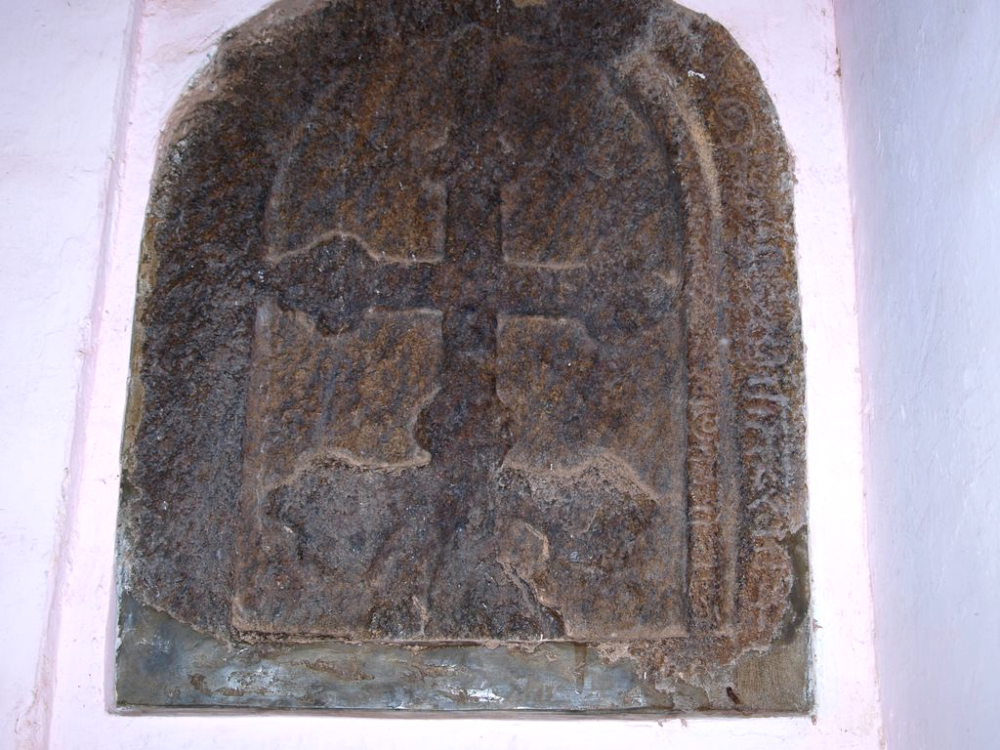
Fig. 6: Muttuchira cross
This cross was found at the old Ruha D Kudisha Church at Muttuchira in Kottayam District in 1923 (Ramanatha Ayyar 1930:75; Hosten 1936:341). This church is now called the Church of Saint Francis of Assisi and is on the east side of the open-air rock cross in front of the present forane church. The old church has the altar on the east side. The Pahlavi-inscribed cross was found on the east wall of the northern altar and was covered by the reredos. When the church was renovated and rebuilt as the Church of St. Francis of Assisi, this cross was rediscovered. Later, a new church was built in front of the old church, which is today’s Ruha D. Kudisha Forane Church. The cross was neglected and damaged, and was eventually placed on the wall of the new church in a little-noticed place, behind a side door on the south side of the main door, facing south. More recently, having become aware of the historical, archaeological and theological importance of this cross, the authorities have placed it as an altar cross, on a side altar on the southern wall. This cross has been severely damaged, most of the Pahlavi inscriptions having been chipped away. It has a rounded top, and no pillars or arch.
6. Alangad Cross
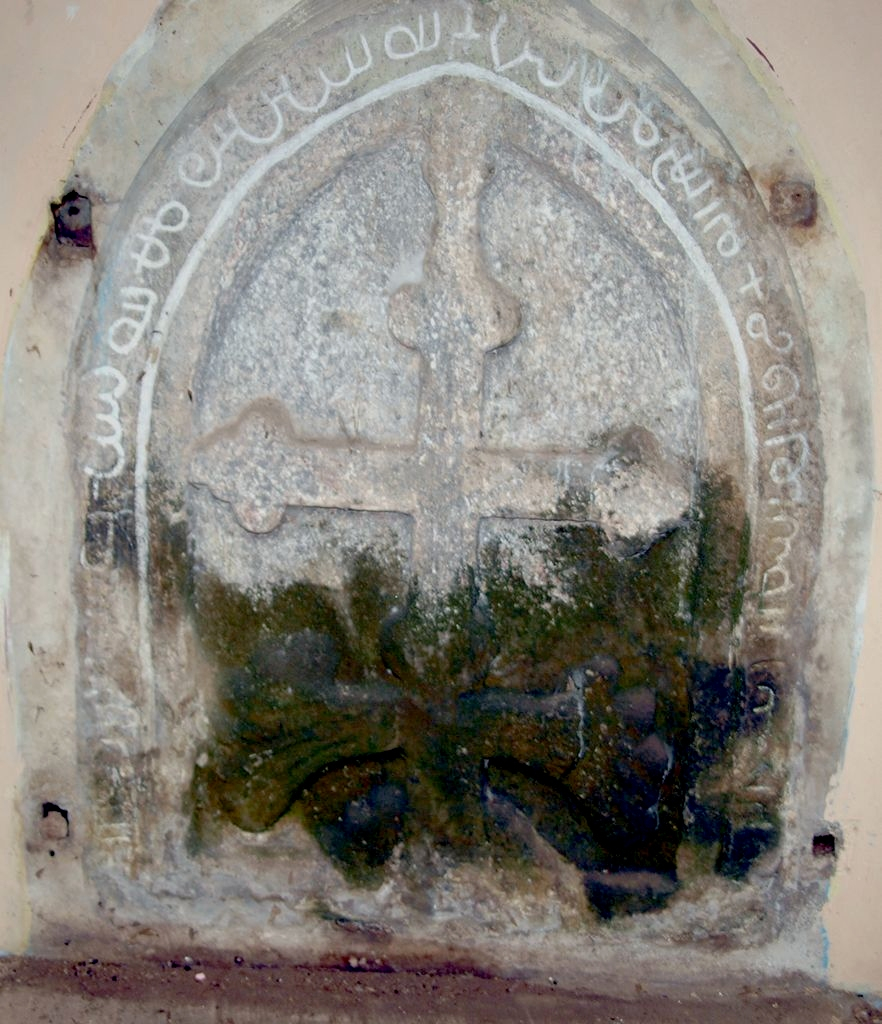
Fig. 7: Alangad cross
This cross was found in 1930, its discovery reported by Rev. Fr Joseph C. Panjikaran. It was found discarded, under the basement of an open-air rock cross near the famous church at Alangad, near Paravoor in the Ernakulam District (Missam 1930:78–79). It has been placed in a roadside chapel at the junction near Alangad Church. This cross was believed to have been an altar cross at the ancient church at Alangad. According to Antonio de Gouvea and du Perron, this church, dedicated to the Holy Cross, was in the most ancient settlement of the Christians of Alangad, and was burned down in a war between the Kingdoms of Parur and Mangattu (old name of Alangad), and only this altar cross survived the flames (Malekandathil 2003:359,136). It is a granite bas-relief slab, with a pointed top and raised edges, on which Pahlavi inscriptions are found. It has no pillar or arch. The cross has arms of equal length with three buds at the end of each arm. There are three steps at the bottom and a floral leaf design, which is mainly directed downwards, with a rudimentary bud directed upwards. The dove is not well-defined.
B.T. Anklesaria, eminent Pahlavi scholar, comments that the Alangad sliva could be the oldest of these crosses—probably an original, which dates back to AD 340—with the inscriptions correctly written (1958:80–82).
7. Agasaim Cross (Goa)
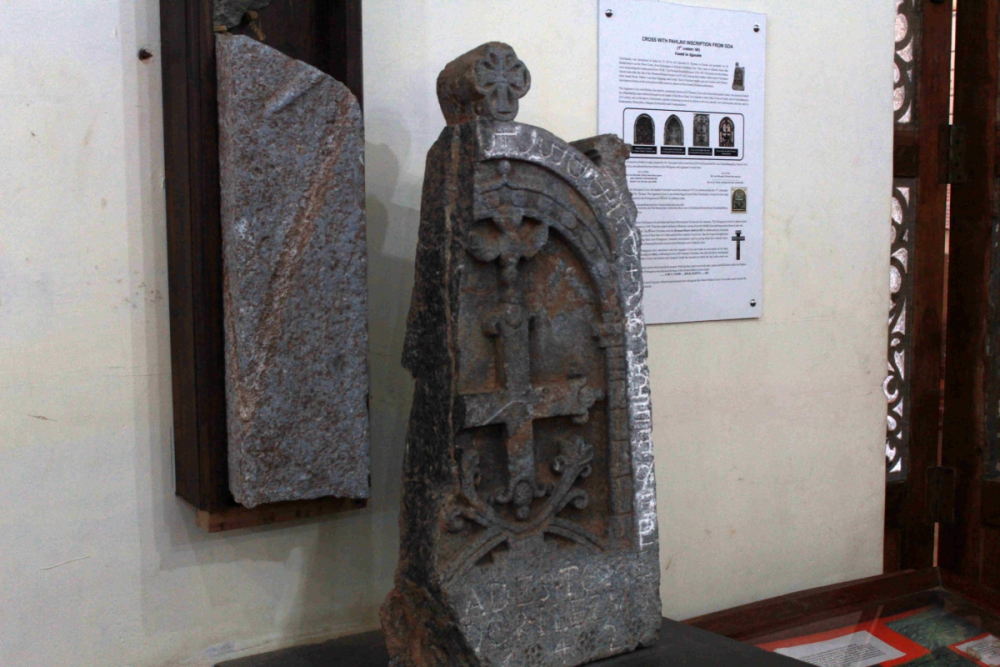
Fig. 8: Agasaim cross (Photo courtesy: Mebin John)
This cross was discovered accidentally in 2001 by Fr Cosme Costa, of the Society of the Missionaries of St. Francis Xavier (SFX). It was found on the premises of Saint Peter’s Chapel in Dandi, Agasaim, in a mound of rock in some shrubbery. The mound of rock was actually the ruins of the base of an open-air rock cross, which was found broken.
This granite cross is very similar to the Mount Cross—a rounded upper border with raised edges and Pahlavi inscriptions, and some Portuguese inscriptions at the base. A niche is carved into it, and on either side of the cross are two pillars, and a rounded arch above. The cross has arms of equal length with three budded ends, three steps at the base, and a dove on the top. The floral design is well-defined with prominent upward- and downward-directed portions, and there is a rounded arch just above the steps. This cross is now kept in the Pilar Museum in Goa.
The Portuguese inscriptions are only partially visible, as part of the granite tablet is missing. which reads ‘A DE S TOME …..DOR ILEZVS….642’. It is likely that this means ‘belongs to Saint Thomas Christians of the region of the neighbouring islands (of Tiswadi)’ (Malekandathil 2002:136).
Epigraphy of the Pahlavi-inscribed crosses of South India
On discovery of the Mount Cross, a few local experts tried—unsuccessfully—to decipher the inscriptions, not realising that they were in the Pahlavi script. In the centuries since its discovery, many scholars have studied these inscriptions, among the most recent being Shilanand Hemraj in 2015. A.C. Burnell (1873:273–74) was the first scholar to recognise that they were written in Pahlavi script.
A Canara Brahmin hired by the Portuguese missionaries in 1562 wrote a 28-line Tamil ballad using the 36 characters in this inscription, which narrated Apostle Thomas’ story in South India (Joseph 1929:24–25). The missionaries suspected the authenticity of this reading, but another Hindu scholar they hired gave a similar reading. Fr Burthey S.J. (1846–95) believed that the inscriptions were Aramaic and Tamil (Joseph 1929:26).
Different interpretations
- A.C. Burnell (1873)
‘In punishment (?) by the cross was the suffering of this (one) (He) who (is) the true Christ and God above, and guide ever pure’ (Burnell 1874:314).
- Martin Haug (1874)
‘He who believes in the Messiah and in God on high and also in the Holy Ghost is in the grace of Him who bore the pain of the cross’ (Burnell 1958:68).
- Baron De Harlez (1892)
‘He who is the true Messiah, the reconciler, the resuscitator, forever purified by virtue of his crucifixion’ (Anklesaria 1958:68; Modi 1926:1–18).
- Dastur Darab Peshotan Sanjana (1914)
‘Such (was) the affliction of the wounding and spearing of him on the cross, who (was) the faithful Messiah, a forgiver, of superior dignity the descendant of Chahar-bukht’ (Anklesaria1958:69).
‘This (was) the affliction of the spearing and wounding of him on the cross who (was) the faithful Messiah, the merciful one, the descendant of the great Abraham, (who was) the descendant of Chahar-bukht.’
‘He of whom the faithful messiah (was) a forgiver, (was) highly exalted; he (was) redeemed from the four (regions of hell); this (was due to) the affliction of the spearing and wounding (of Messiah) on the cross.’
‘This (was) the affliction on the cross even of the messenger of Jehovah.’
- Jivanji Jamshedji Modi (1924)
‘I, beautiful bird from Nineveh, (have come) to this (country). Written (by) Mar Shapur. I whom…(?) Messiah, the forgiver, freed from danger (or terror)’ (Modi 1926:11,18).
- C.P.T. Winkworth (1929)
‘My Lord Christ, have mercy upon Afras son of Chahar-bukht, the Syrian who cut this’ (Winkworth 1929:243). Winkworth’s paper was read at Oxford in 1928 at the Seventh International Congress of Orientalists and was accepted by Iranian scholars as well.
- Winkworth’s Revised Interpretations (1930)
‘My Lord Christ, have mercy upon Afras, son of Chaharbukht, the Syrian who preserved this’ (Joseph 1928:267–268).
‘My Lord Christ, have mercy upon Afras, son of Chaharbukht, the Syrian who put it around’ (Joseph:267–268).
- E.W. West (1896)
‘He whom the suffering of the selfsame Messiah, the forgiving and upraising, (has) saved, (is) offering the plea whose origin (was) the agony of this’ (West 1896–97:175).
- W.B. Henning (1958)
‘Our Lord Jesus Christ, have mercy about son of Chaharbuxt, son of George who erects this.’ (Cereti et al 2002:285–310).
- Gerd Gropp (1970)
‘May our Lord Messiah have mercy on Gabriel, son of Chaharbokht, grandson of Durzad who made this (cross)’ (Nedungatt 2008:386).
- Philippe Gignoux (1995)
‘May our Lord the Messiah have mercy upon Sabriso, son of Chaharboxt the deft, who sculpted this (Cross)’ (Nedungatt 2008:385–386).
- Carlo G. Cereti, Luca M. Oliviery, Fr Joseph Vazhuthanappalli (CICAAR-CASI) (2002)
‘Our Lord Christ, have pity on Sabriso, son of Chaharboxt, son of Suray who bore (brought?) this (Cross)’ (Cereti et al 2002:285–310).
- B.T. Anklesaria (1958)
‘Lord Mishiha, saviour too, and supreme revelation too (of) four Apostles Syrians who saved this. (Lord and saviour and supreme revelation of the four apostles gave salvation)’ (Anklesaria 1958:70).
- Shailanand Hemraj (2014)
Shailanand Hemraj is a linguist and epigraphic palaeographic researcher at Allahabad University. ‘My Lord is the Mishiha and life giver, who be praised forever because of salvation. Indeed the Lord suffered crucifixion to redeem us’ (Hemraj 2015:20).
Epigraphic analysis
Unintelligent copy: Winkworth’s theory
C.P.T. Winkworth did a serious study of these crosses and found that the inscriptions on them are ‘unintelligent copies’ (copies of an original template by a craftsman who was not familiar with the script) of an original template. Winkworth proposed in 1929 that Mount Cross is the original and that the rest of the inscriptions are copies of it. These inscriptions show only minor differences in the letters. On careful study, he found that some letters are not cut correctly, some letters are mirror images, some words were incomplete, and a letter was upside down.
He found that all these crosses bear Pahlavi inscriptions, but with minor differences in the letters. On careful study of the Kadamattom Cross and the other three crosses—namely Mount Cross and two Kottayam Valiyapally crosses—he found that the Kadamattom cross is an unintelligent copy of the other three, probably of the larger Kottayam cross. He proposes that a series of rubbings on paper or parchment were taken from the original in order to reproduce the inscriptions and that while doing so, many characters were not reproduced correctly. The sculptor was probably illiterate in Pahlavi, and so may have unknowingly used the reverse side of the paper or medium used for rubbings, and so produced a mirror image of the letter. As a conclusion of his studies, he argues that the smaller Kottayam cross (the north altar cross) is an ancient one from which the Mount Cross inscription was copied. The larger Kottayam cross (the south altar cross) is an unintelligent copy, and the Kadamattom cross was an even more unintelligent copy of the larger Kottayam cross.
Alangad could be the most ancient: Anklesaria’s theory
B.T. Anklesaria studied the Alangad cross and inscription in detail and had the opportunity to study other crosses as well. With orthographical and epigraphical evidence, Anklesaria concluded that the inscription of the Alangad cross could be the most ancient, and that the inscription could be dated as early as AD 340. He argued that the Alangad cross is the only cross where the ninth word—suriha—is cut correctly. The conjunct ich at the end of the third word (awakhs-aich) and seventh word (afras ich) are written distinctly on the Alangad cross and the smaller Kottayam cross, but the ich at the end of the third word is dropped in the larger Kottayam cross. The ch of the eighth word chahar-bap is connected by mistake to the ich of the seventh word on both Kottayam crosses, but on the Alangad cross, it is cut correctly, separate from the ich. The Alangad cross is the only cross where the conjunction u is prefixed to the fourth word madam.
The Alangad cross has a crack at the bottom, which makes the b in the eleventh word read as v, but it is correctly written in both Kottayam crosses—Mount Cross and Muttuchira cross—confirming that this crack was formed after copying, possibly when the church was burned down in a war between the Kingdoms of Parur and Mangattu (Antony 2014:271).
Conclusion
The Pahlavi-inscribed granite crosses of South India are the most ancient artefacts of Christianity in India. These crosses—once the only icon of worship in churches of Saint Thomas Christians—were probably brought by Persian Christians who fled Persia due to persecution. The design of the crosses evolved locally through adaptations from Indian art and culture, becoming the earliest, and only, model of inculturated Christian emblem in India.
References
Anklesaria, B.T. 1958. ‘The Pahlavi Inscriptions on the Crosses of Southern India’. Journal of K R Cama Oriental Institute 39: 68, 80–82. Bombay.
Antony, M.T. 2014. ‘Alengad Sliva, The Neglected Jewel of the Ancient Christian Settlement of Alengad’, The Harp XXX: 271.
Ayyar, A.S. Ramanatha. ‘Muttusira Inscriptions’, Travancore Archaeological VIII.II:75.
Bickelmann, Eckerhard. 1970. ‘The Saint Thomas Cross, An Early Example of the Inculturation of Christian Art in India’, Indian Church History Review IV (2): 66.
Burnell, A.C. 1874. ‘On Some Pahlavi Inscriptions in South India’, The Indian Antiquary 3: 308. Bombay: Thacker, Vining and Co.
Cereti, Carlo C., Luca M. Oliviery, and Joseph Vazhuthanapalli. ‘The Problem of the Saint Thomas Crosses and Related Questions, Epigraphical Surveys and Preliminary Research’, East and West 52: 285–310.
Chan, Kim-Kwong. 2010–2011. ‘Lotus and Swastika in Assyrian Church in China: Buddhist Legacy for Aryan Heritage?’, Ching Feng, A Journal on Christianity and Chinese Religion and Culture 10: 1,2.
Costa, Cosme Jose. 2009. Apostolic Christianity in Goa and in the West Coast. Pilar. Goa: Xavierian Publication Society.
Drake, F.S. 1962. ‘Nestorian Crosses and Nestorian Christians in China under the Mongols’, Journal of the Hong Kong Branch of the Royal Asiatic Society II: 11-25. URL http://www.jstor.org/stable/23881247
Encyclopaedia Britannica. ‘Pahlavi Language’. Online at https://www.britannica.com/topic/Pahlavi-language (accessed on April 12, 2018).
Gregory of Nazianzen. Oratio XXIX Theologica Tertia, Patrologia Greeca. Paris: J.P. Migne.
Hosten, H. 1936. Antiquities of San Thome and Mylapore. Madras: Diocese of Mailappore.
Iturriotz DC, Rev. Fr Carmel. 1930. The Mount Cross of Saint Thomas and its Pahlavi Inscriptions, 1547–62 AD, translated from the Archives of the Society of Jesus, Esplendores da Religio 1930: 160–162.
Joseph, T.K. 1923. ‘Another Persian Cross in Travancore’, Indian Antiquary vol. 52 (December): 355. Bombay: British India Press Buzgaon.
Joseph, T.K. 1929. Malabar Christians and Their Ancient Documents. Trivandrum: Popular Press.
Joseph, T.K., ed. 1997. ‘Revised Interpretation of Pahlavi Cross Inscription of Southern India’, Kerala Society Papers, Series 5: 267–268. Trivandrum: Kerala Gazetteers.
Keay, F.E. 1960. A History of the Syrian Church in India. Delhi: ISPCK.
Kesson, John. 1854. The Cross and the Dragon, Or, The Fortunes of Christianity in China. London: Smith, Elder, & Co.
Klijn, A.F.J. 1960. ‘The So-Called Hymn of the Pearl, Acts of Thomas’, Vigilie Christiane 14.3: 154–64.
Kollaparambil, Jacob. 1994. ‘The Persian Crosses of India are Christian, Not Manichaean’, Christian Orient XV (1): 29. Kottayam.
Koonammakkal, Thomas. 2012. Elements of Syro-Malabar History. Kottayam: Beth Aprem Nazrani Dayara.
Lau, Hua Teck. 2003. ‘The Cross and the Lotus’, Church and the Society 26.2:87–88.
Malekandathil, Pius. 2002. ‘Discovery of a Pahlavi Cross from Goa: A New Evidence for Pre-Portuguese Christian Settlement in Konkan.’ Christian Orient XXIII (3):136. Kottayam.
Malekandathil, Pius, ed. 2003. Jornada of Dom Alexis De Menezes: A Portuguese Account of the Sixteenth Century Malabar. Kochi: LRC Publications.
McVey, Kathleen E. 2002. ‘Ephraim the Syrian’, The Early Christian World II. Philip Francis Esler (ed.), 1228. London: Routledge.
Medleycot, Adolf E. 1905. India and the Apostle Thomas. David Nutt, 57-59. Long Acre, London: Ballantyne Hanson and Co.
Meyers, Abe. 2014. ‘Proposal for Encoding Book Pahlavi in the Unicode Standard Version 1.2’. Online at https://www.unicode.org/L2/L2014/14077r-book-pahlavi.pdf (viewed on April 28, 2018).
Modi, J.J. 1929. ‘A Christian Cross with a Pahlavi Inscription Recently Discovered in the Travancore State’. In Asiatic Papers Part IV: Papers read before the Bombay Branch of the Royal Asiatic Society, 1-18. Bombay: Times of India Press.
Moyne, J.A. 1974. ‘Sasanian Pahlavi Inscriptions: A Concordance’, Computers and Humanities 8.1: 27–39.
Mundadan, A.M. 1967. The Arrival of the Portuguese in India and the Thomas Christians Under Mar Jacob 1498-1552 (Dharmaram Studies No. 2). Bangalore: Dharmaram College.
Nedungatt, George. 2008. ‘Quest for the Historical Thomas Apostle of India, a Re-reading of Evidence’, 386. Bangalore: Theological Publications in India.
Parry, K. 1996. ‘Images in the Church of the East: The Evidence from Central Asia and China’. Bulletin of John Rylands Library, 145. Manchester: Manchester University Press.
Mihindukulasuriya, Prabo. 2011. ‘Persian Christians of the Anuradhapura Period’, A Cultured Faith: Essays in Honour of Professor G.P.V. Somaratna on His Seventieth Birthday. Colombo: Colombo Theological Seminary.
Ernakulam Missam, 1930. ‘Alangatte Purathana Thoma Sleeha Kurisu.’ Ernakulam Missam, Ernakulam.
Shailanand, Hemraj. 2015. ‘Pahlavi Text and Imagery Context of the Persian Cross in South India Part I’, Asian Journal of Religious Studies 60.1:20.
S.S. Gervasis & Prothasis Forane Church. 2018. ‘About’. Online at http://www.kothanalloorforanechurch.com/churchHistory.html (viewed on February 3, 2018).
Vazhuthannappally, Joseph. Archaeology of Mar Sliba. Kottayam: OIRSI Publications.
West, E.W. 1896–97. ‘Inscriptions Around Crosses in South India’. Epigraphia Indica IV: 175. Calcutta: Government of India, Office of the Superintendent of Government Printing.
Winkworth, C.P.T. 1929. ‘A New Interpretation of the Pahlavi Cross-Inscriptions of Southern India.’ The Journal of Theological Studies 30 (119): 237–244. Oxford University Press. http://www.jstor.org/stable/23950669
Endnotes
[i] The Alopen documents and the Ching-cheng documents refer to this. Between 1901 and 1908, seven manuscripts were discovered in the Tun-huang cave. Two of them—the Hsu-t’ing-mishih-so-ching, and the I-shen-lun—were probably written for the Emperor during the Chen-kuan era, shortly after the arrival of Alopen. The other documents include Yu-ti-erh, I-t’ien-lun-ti-i and Shih-tsun-pu-shih-lun. The Ching-cheng documents include one stele inscription and four other documents.
[ii] Liturgical prayers in the Chaldean tradition mention, ‘by the blessed Saint Thomas, the Chinese and Cushites were converted to the truth. By the Blessed Saint Thomas, the Indian idolatries were dissipated. By St. Thomas they received the virtue of baptism and the adoption of children. By him the kingdom of heaven penetrated to China’.
[iii] Burnell suggested that these Pahlavi inscribed crosses were left by the Persian Christians who preceded the Syrians. He assumed that the earliest Christian settlement in Kerala was Persian, and probably Manichean or Gnostic, as there was no persecution of Christians in Persia until the 6th century, but there was persecution of Manicheans after Manes was executed in AD 272. It is not unreasonable to suppose that many of them emigrated to India and Ceylon. It seems that Burnell was unaware of the severe persecution suffered by Christians in Persian empire in the 4-5th centuries especially during the reign of Shapur II in the AD 340s. He thought Syrian Christians means those from Syria. He was unaware of the large body of evidence about the relation between Syriac Christianity of Persia and India.
[iv] Mar Aprem wrote that ‘the wood will resemble the cross through the various uses of it. It carries on the sea, it guides on the land, it multiplies itself in its advantages and becomes rich in its assistance’.
[v] In many places in Kerala where churches are devoted to Mar Sliva, devotees also refer to the sliva as kuriyachan, meaning kurish acha, personifying the cross. We can conclude that this must be the continuation of an ancient usage in the Syriac tradition.
[vi] Makara Torana is a widely seen theme in Indian architecture. It is an ornamental arch originating from the mouths of two water creatures - Makara - on either side. This is seen widely in many ancient Hindu temples.
[vii] Marco Polo, in 1293, wrote that ‘the body of Saint Thomas the Apostle lies in this province of Malabar in a little town’. John of Montecorvino (1292–1293) wrote that for 13 months, he stayed in India, wherein stands the church of Saint Thomas the Apostle. There, he baptised people and buried his companion in the Church of Saint Thomas. Henry Yule’s Cathay reports Blessed Odoric (1324–25) visiting Malabar, (he uses the term Minibar) and then continuing for another ten days to Mobaar, where lay the body of Thomas Apostle. John De Marignolli writes of visiting Columbum/Quilon in 1349, and then proceeding to visit the shrine of the Apostle Thomas in Mirapolis. Niccolo De Conti (1425–1430) visited a maritime city named Malepur, situated in the second gulf of India, the Bay of Bengal, where the body of Saint Thomas is honourably buried. Narrations of Joseph, the Indian (1501) confirm that Saint Thomas Christians go to Mailappore on pilgrimage, where the body of Saint Thomas is buried. Duarte Barbosa, in 1514, also reports the prevailing tradition that Mailappore was the site of the martyrdom of Saint Thomas the Apostle, and that his tomb is there.
[viii] The Portuguese army killed the King of Vadakkumkoor. The Vadakkumkoor army then formed into chavers (suicide squad) and vowed to kill the Christians for being co-religionists of the Portuguese. All of the Christian ministers of the murdered King from the Kunnacherry family had to leave the country. A group of Christians fled to Mulanthuruthy with Venthamudy (special crown used in marriage ceremony), which is still preserved at Mulanthuruthy. Another group fled to Kottayam and built a church there, in which the crosses were installed (Lucas 1992).
